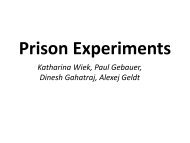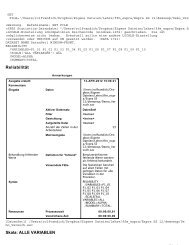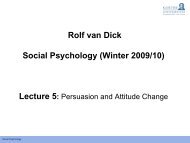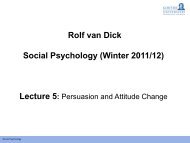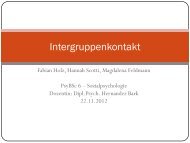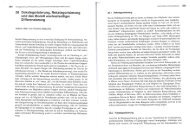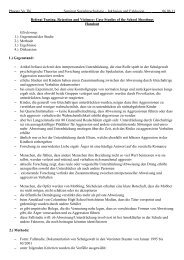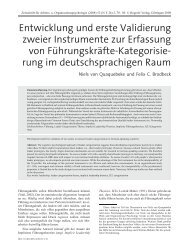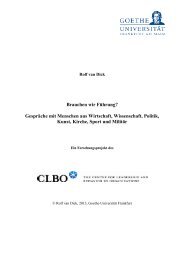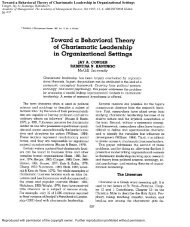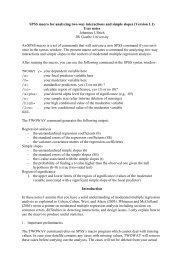Social Identity Theory and Self-categorization Theory: A Historical ...
Social Identity Theory and Self-categorization Theory: A Historical ...
Social Identity Theory and Self-categorization Theory: A Historical ...
Create successful ePaper yourself
Turn your PDF publications into a flip-book with our unique Google optimized e-Paper software.
210 <strong>Social</strong> <strong>Identity</strong> <strong>Theory</strong> <strong>and</strong> <strong>Self</strong>-<strong>categorization</strong> <strong>Theory</strong><br />
context (Oakes, Haslam, & Turner, 1994; Spears, Oakes, Ellemers, & Haslam,<br />
1997; Tajfel, 1981). Possibly reflecting the growing presence of the social<br />
identity approach in North America, recent social cognitive approaches to<br />
stereotyping are now much more likely to acknowledge that stereotyping<br />
occurs in a ‘hot’ social context. For example, the stereotype content model<br />
(Fiske, Cuddy, Glick, & Xu, 2002) argues that the content of stereotypes<br />
is dependent on the structural relationships between groups with respect<br />
to status <strong>and</strong> competition.<br />
Others have used the social identity approach to help explain crowd<br />
violence <strong>and</strong> rioting. For many years, social psychologists have subscribed<br />
to the ‘deindividuation’ notion of aggression (Zimbardo, 1970). The<br />
argument was that environmental forces such as anonymity, high cohesiveness,<br />
<strong>and</strong>/or high arousal lead to lower self-awareness, which in turn leads to a<br />
cluster of symptoms that promote anti-social behavior: Weakened restraints<br />
against impulsive behaviour, increased responsiveness to current emotional<br />
states, an inability to monitor or regulate one’s own behaviour, less concern<br />
about being evaluated by others, <strong>and</strong> lowered ability to engage in rational<br />
planning. Working from the social identity perspective, Reicher, Spears,<br />
<strong>and</strong> Postmes (1995) argued that anonymity weakens the relative contribution<br />
of one’s personal identity to self-concept <strong>and</strong> increases the relevance of<br />
one’s social identities. Deindividuation was interpreted not as a loss of<br />
identity, but rather as a shift in identity from the personal to the social<br />
level. The consequence of this is that people would become more sensitive<br />
<strong>and</strong> responsive to the norm implied by the context, which may be anti-social<br />
or pro-social. A meta-analysis <strong>and</strong> review of the literature showed evidence<br />
in favor of this perspective (Postmes & Spears, 1998).<br />
SIT also proved to be influential in our underst<strong>and</strong>ing of rioting behavior<br />
(Reicher, 1987). A prevailing theory of rioting behavior argued that people<br />
came together in crowds in a normative vacuum. The actions of distinctive<br />
individuals in the crowd then become an assumed norm for that context,<br />
which has a contagious effect on byst<strong>and</strong>ers (Turner & Killian, 1957).<br />
Reicher challenged this notion by arguing that (a) crowds gather for a<br />
specific purpose <strong>and</strong> bring with them a clear set of shared norms; (b)<br />
crowd violence often has an intergroup component; (c) crowds often behave<br />
logically, even when they are violent, with attacks frequently specific to<br />
symbolic intergroup targets; <strong>and</strong> (d) during <strong>and</strong> after a riot, participants<br />
often feel a strong sense of social identity.<br />
Finally, the social identity approach presented a new perspective on<br />
social influence, conformity, <strong>and</strong> power. From a SCT perspective, the norms<br />
of relevant ingroups are a crucial source of information about appropriate<br />
ways to think, feel, <strong>and</strong> act. Through the process of depersonalization,<br />
highly identified ingroup members internalize the norms of the group <strong>and</strong><br />
assume that others have as well. Thus, it is argued that the traditional<br />
distinction between normative <strong>and</strong> informational influence is made obsolete<br />
because there is an implicit shared expectation of agreement among group<br />
© 2008 The Author <strong>Social</strong> <strong>and</strong> Personality Psychology Compass 2/1 (2008): 204–222, 10.1111/j.1751-9004.2007.00066.x<br />
Journal Compilation © 2008 Blackwell Publishing Ltd



